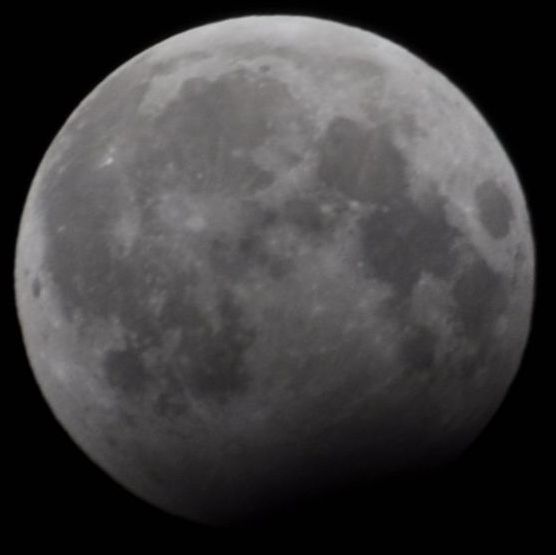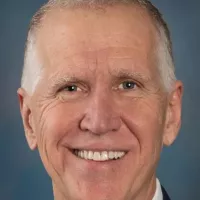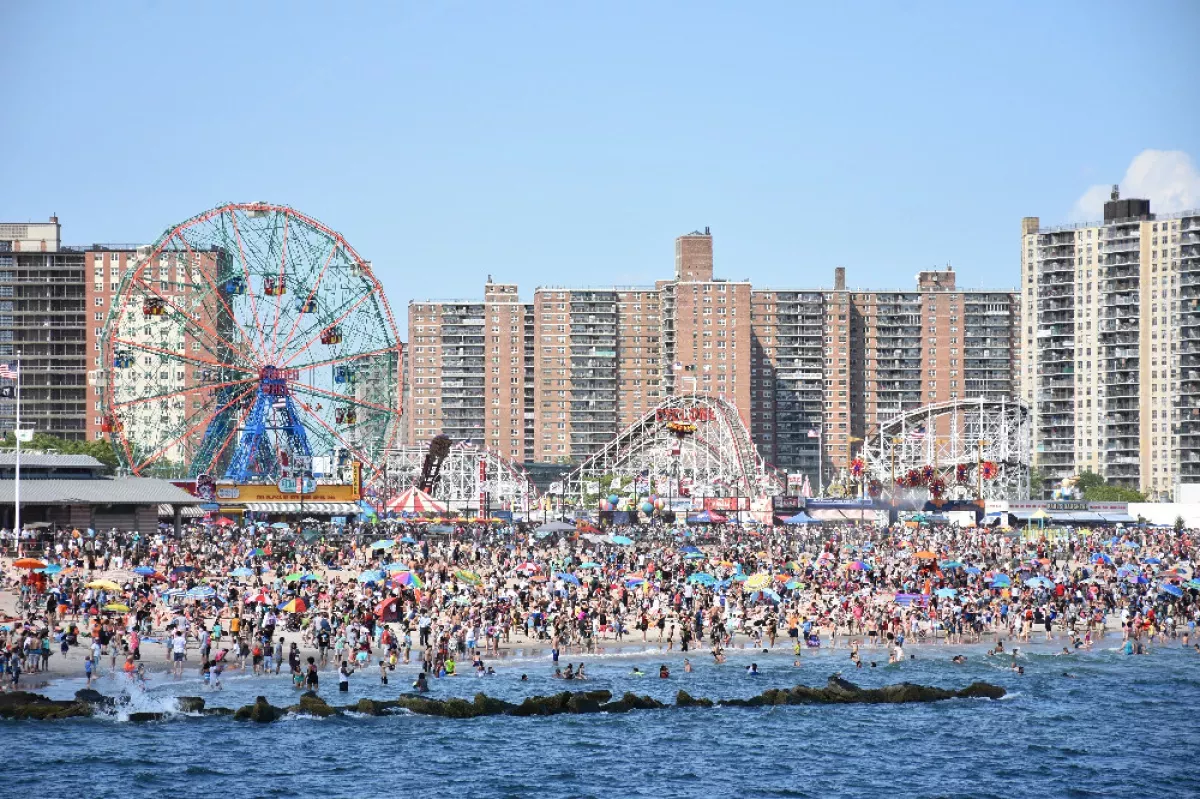Coney Island is a renowned neighborhood and entertainment area located in Brooklyn, New York City. Situated on a peninsula, it's bordered by Brighton Beach, Lower New York Bay, and Gravesend. Historically an outer barrier island of Long Island, land fill connected it to the mainland in the early 20th century. Coney Island is famed for its amusement parks, boardwalk, and beach, making it a significant recreational destination within New York City. The Coney Island peninsula also encompasses Brighton Beach and Manhattan Beach.
1901: Library Deposit Station Opened
In 1901, the Brooklyn Public Library (BPL)'s Coney Island branch opened as an unmanned deposit station.
1902: Sea Lion Park Closed
In 1902, Sea Lion Park closed down. It was the first amusement park to charge entry fees.
1903: Luna Park opened
In 1903, Luna Park opened on the site of the former Sea Lion Park. The park was lit by electricity at night and featured a variety of attractions, including A Trip to the Moon, an attraction based on Jules Verne's novel From the Earth to the Moon.
1904: Dreamland Opens
Dreamland opens in 1904.
1906: B&B Carousell Built
The B&B Carousell was built circa 1906-1909, featuring a traditional roll-operated fairground organ.
1907: Fire at Steeplechase Park
In 1907, Steeplechase Park had to be completely rebuilt after a fire.
1909: Horse racing outlawed in New York State
In 1909, patronage at the original resorts declined after horse racing was outlawed in New York State.
1909: B&B Carousell Built
The B&B Carousell was built circa 1906-1909, featuring a traditional roll-operated fairground organ.
1911: Dreamland Closed
Dreamland closes in 1911.
1911: Library Branch Opened
In 1911, the Brooklyn Public Library's Coney Island branch opened.
1915: Sea Beach Line upgraded to a subway line
In 1915, the Sea Beach Line was upgraded to a subway line, improving transportation access to Coney Island.
1916: Nathan Handwerker starts selling hot dogs at Coney Island
In 1916, Nathan Handwerker began selling hot dogs at Coney Island for a nickel each, later expanding into the famous Nathan's Famous hot dog chain.
1917: Subway Station Construction
From 1917 to 1920, the Coney Island–Stillwell Avenue station was built as a replacement for the former surface-level Culver Depot.
1919: Stillwell Avenue station opens
In 1919, the opening of the Stillwell Avenue station ushered in Coney Island's busiest era, facilitating travel for over a million people on the busiest summer days.
1920: Subway Station Construction
From 1917 to 1920, the Coney Island–Stillwell Avenue station was built as a replacement for the former surface-level Culver Depot.
1920: Wonder Wheel opened
In 1920, the Wonder Wheel opened, adding to Coney Island's quality as an amusement destination.
1921: The Comet Built
The Comet roller coaster was built in 1921 next to the current site of the Cyclone.
1922: Construction of Riegelmann Boardwalk began
In 1922, construction began on the Riegelmann Boardwalk, which facilitated the redeposition of sand on the beaches through beach nourishment.
1923: Construction of Riegelmann Boardwalk completed
In 1923, construction was completed on the Riegelmann Boardwalk, which facilitated the redeposition of sand on the beaches through beach nourishment.
1923: Riegelmann Boardwalk opened
In 1923, the Riegelmann Boardwalk opened, enabling crowds to disperse away from Surf Avenue.
1923: City Bought Waterfront Land
In 1923, the city bought all the land on the waterfront and created the Riegelmann Boardwalk and Beach, making the beaches public.
1923: Childs Restaurant Constructed
The Childs Restaurant was originally constructed in 1923.
1924: Portion of Coney Island Creek infilled
In 1924, local landowners and the city filled a portion of Coney Island Creek.
1925: Shore Theater opened
In 1925, the Shore Theater opened, adding to Coney Island's quality as an amusement destination.
1925: Original Thunderbolt Coaster Constructed
The original wooden Thunderbolt coaster was constructed in 1925.
1927: Coney Island Cyclone Opens
In 1927, the Coney Island Cyclone, one of the United States' oldest wooden roller coasters still in operation, opened.
1932: Large fire at Coney Island
In 1932, a large fire at Coney Island left at least a thousand people homeless.
1937: Robert Moses publishes report on possible redevelopment of Coney Island
In 1937, New York City parks commissioner Robert Moses published a report on the possible redevelopment of Coney Island, which would have entailed the addition of parking lots and reconstruction of part of the boardwalk.
1939: Parachute Jump at NY World's Fair
In 1939, the Parachute Jump was originally built as the Life Savers Parachute Jump at the New York World's Fair.
1941: Parachute Jump opened
In 1941, the Parachute Jump contributed to Coney Island's allure as an amusement destination.
August 1944: Luna Park destroyed by fire
In August 1944, Luna Park was destroyed by a fire.
1944: Luna Park Closed
Luna Park closes in 1944.
1945: The Comet Destroyed
The Comet roller coaster was destroyed in 1945.
1946: Two new rides constructed after World War II
In 1946, at the end of World War II, two new rides were constructed in Coney Island, despite earlier delays caused by material shortages.
1949: Land rezoned for residential use
In 1949, Moses had Luna Park's land rezoned for residential use, with plans to demolish "about a third" of attractions along Surf Avenue and replace these with housing.
1953: Moses proposes rezoning most of the peninsula
In 1953, Robert Moses proposed that most of the peninsula be rezoned for various uses, claiming that it would be an "upgrade" over the existing zones. This was met with public resistance, leading to the reinstatement of an amusement-only zone between West 22nd and West Eighth Streets.
1953: New building for the New York Aquarium was approved
In 1953, a new building for the New York Aquarium was approved for construction in the neighborhood.
1954: Library Branch Built
In 1954, another branch of the Brooklyn Public Library was built in Coney Island, referred to as "the first-ever library built on stilts over the Atlantic Ocean."
1954: Construction started on the new New York Aquarium
In 1954, construction started on the new New York Aquarium, which was expected to revitalize Coney Island.
1955: Coney Island still includes four children's amusement areas, five roller coasters, several flat and dark rides, and various other attractions
In 1955, Coney Island still included four children's amusement areas, five roller coasters, several flat and dark rides, and various other attractions such as the Wonder Wheel.
1955: Moses's proposal to extend the Coney Island boardwalk east to Manhattan Beach was denied
In 1955, Robert Moses's subsequent proposal to extend the Coney Island boardwalk east to Manhattan Beach was denied.
1955: Oriental Scenic Railway Demolished
In 1955, the Oriental Scenic Railway, created by LaMarcus Adna Thompson in 1887, was demolished to be replaced with a "hot rod" amusement ride.
1956: Last Performance of Ringling Bros. and Barnum & Bailey Circus before 2009
1956 was the last year the Ringling Bros. and Barnum & Bailey Circus performed in Coney Island before their return in 2009.
June 1957: The New York Aquarium's new site opened
In June 1957, the New York Aquarium's new site opened with several dozen rides in Coney Island.
1957: New York Aquarium Opened
In 1957, the New York Aquarium opened on the former site of the Dreamland amusement park.
1961: Coney Island had 34,000 residents
In 1961, Coney Island had 34,000 residents.
1962: Astroland Opens
Astroland opens in 1962 at the site of the current Luna Park.
1962: Astroland announced for the boardwalk
In 1962, Astroland, a small amusement park, was announced for the Coney Island boardwalk, with plans to open the following year.
1962: More fill added to Coney Island Creek during construction of the Verrazzano-Narrows Bridge
In 1962, more fill was added to Coney Island Creek during the construction of the Verrazzano-Narrows Bridge.
1964: Steeplechase Park closed permanently
After the 1964 season, Steeplechase Park, the last remaining large amusement park in Coney Island, closed permanently.
1964: Decrease in visitors to Coney Island
During the summer of 1964, Coney Island experienced a large decrease in the number of visitors due to the 1964/1965 World's Fair and other factors, resulting in the lowest profits for concessionaires in a quarter-century and a significant drop in visitors for ride operators.
1965: Decrease in visitors to Coney Island
During the summer of 1965, Coney Island experienced a large decrease in the number of visitors because of the 1964/1965 World's Fair at Flushing Meadows–Corona Park in Queens.
1965: Fred Trump announced plans to build luxury apartments on the old Steeplechase property
In 1965, developer Fred Trump announced his intentions to build luxury apartments on the site of the former Steeplechase Park.
1966: Almost 100,000 people lived in the peninsula
By 1966, the Coney Island peninsula housed almost 100,000 people due to new housing developments.
1966: Developers tried to revitalize the Coney Island boardwalk
In 1966, developers attempted to revitalize the Coney Island boardwalk as an amusement area. Trump destroyed Steeplechase Park's Pavilion of Fun during a highly publicized ceremony that September.
January 1968: Proposal for a state park on the Steeplechase site
In January 1968, New York City parks commissioner August Heckscher II proposed that the New York state government build an "open-space" state park on the Steeplechase site.
1969: Condemnation of the Steeplechase site started
In 1969, the condemnation of the Steeplechase site began as the city moved forward with plans to purchase the land for a park.
1975: Coney Island Cyclone demolition considered
By 1975, the city was considering demolishing the Coney Island Cyclone in favor of an extension of the adjacent New York Aquarium.
1975: HUD grant threatened
In 1975, the United States Department of Housing and Urban Development nearly withdrew a proposed grant of $2 million to fund the proposed state park in Coney Island. The city ultimately accepted the grant, though different city agencies still disagreed over whether to return the funds.
1977: Tornado Coaster Destroyed by Arson
In 1977, the Tornado wooden coaster was destroyed by arson.
1979: Gambling legalization feasibility report and casino proposal.
In 1979, New York State announced it would conduct a report on the feasibility of legalizing gambling. Mayor Ed Koch proposed opening casinos in New York City, including Coney Island, to revitalize the area's economy.
1980: Coney Island Museum Opened
In 1980, the Coney Island Museum opened, featuring a collection of memorabilia chronicling the history of the neighborhood.
1980: Parachute Jump Listed on NRHP
In 1980, the Parachute Jump was listed on the National Register of Historic Places (NRHP).
1980: Kaufman's site operation ends
Norman Kaufman continued to operate his site in Coney Island until the end of summer 1980.
1981: Gambling legalization proposal fails
By 1981, the state's interest in legalizing gambling had subsided, and the New York state legislature failed to take action on such proposal.
1982: City advertises for developers to redevelop amusement park area
In 1982, after acquiring Kaufman's rides, the New York City government began advertising for developers to redevelop the former amusement park area.
1983: Original Thunderbolt Coaster Closed
The original wooden Thunderbolt coaster closed in 1983.
1985: Steeplechase Park rebuilding approved
In 1985, the city agreed to restaurant mogul Horace Bullard's proposal to rebuild Steeplechase Park for $55 million.
December 1986: Urban Development Corporation proposes baseball stadium and indoor arena
In December 1986, the New York State Urban Development Corporation formally proposed a 17,000-seat minor-league baseball stadium and a 15,000-seat indoor arena in Coney Island.
1986: Steeplechase Park opening delayed
In 1986, the opening of the rebuilt Steeplechase Park was delayed while the New York City Planning Commission compiled an environmental impact report.
1987: Steeplechase Park rebuilding cost nearly doubles
By early 1987, the cost of rebuilding Steeplechase Park nearly doubled, to $100 million.
1988: Cyclone Landmark Designation
In 1988, the Coney Island Cyclone was designated as a city landmark.
1988: Cyclone roller coaster designated as a landmark
In 1988, the Cyclone roller coaster in Coney Island was made a New York City designated landmark.
1989: Contract ready for 60-ride amusement park construction
By 1989, Bullard and the city were ready to sign a contract that would allow the developer to construct a 60-ride amusement park on a 25-acre waterfront strip, which would be completed by 2002.
1989: Parachute Jump and Wonder Wheel designated as landmarks
In 1989, the Parachute Jump and the Wonder Wheel in Coney Island were made New York City designated landmarks.
1989: Parachute Jump Landmark Designation
In 1989, the Parachute Jump was designated as a city landmark.
1989: Wonder Wheel Landmark Designation
In 1989, the Wonder Wheel was designated as a city landmark.
1990: Crime Rate Decrease Since 1990s
Between 1990 and 2022 crimes across all categories in the 60th precinct had decreased by 77.5%.
1990: Storefronts on Mermaid Avenue decline
By 1990, storefronts on Mermaid Avenue in Coney Island had decreased by 90%, from over 400 stores before the urban renewal to 39 stores afterward.
1991: Cyclone Listed on NRHP
In 1991, the Coney Island Cyclone was listed on the National Register of Historic Places (NRHP).
1993: Decrease in Major Crimes Since 1993
Between 1993 and 2010, major crimes decreased by 72% in Coney Island.
1994: Giuliani negates Bullard deal and approves baseball stadium
In 1994, after Rudy Giuliani took office as New York City mayor, he negated the Bullard deal by approving the construction of a minor-league baseball stadium on the site allotted for Steeplechase Park.
1996: Housing development completed
In 1996, a four-phase, 873-unit housing development in Coney Island was completed.
1997: Ratner proposes entertainment complex
In 1997, developer Bruce Ratner proposed constructing a $100 million entertainment complex with a "virtual-reality amusement park" and a movie theater multiplex in Coney Island.
1998: Giuliani cancels Sportsplex and entertainment complex
In 1998, Giuliani canceled Sportsplex and the entertainment complex, and instead unveiled another plan where only the parking lot would be built.
2000: Math Achievement Increase
In 2000, math achievement in Coney Island rose to 53 percent.
2000: City approves Keyspan Park construction
In 2000, the city approved the $31 million project to construct Keyspan Park in Coney Island using the funds from the canceled Sportsplex.
2000: Original Thunderbolt Coaster Torn Down
In 2000, the original wooden Thunderbolt coaster was torn down during the construction of nearby Keyspan Park.
2000: Population Counted in Census
In 2000, the population of Coney Island and Sea Gate was counted as 34,267 in the United States Census.
2001: Subway Station Rebuilt
From 2001 to 2004, the Coney Island–Stillwell Avenue station was rebuilt.
2001: Venue now known as Maimonides Park opened
In 2001, Coney Island experienced revitalization with the opening of the venue now known as Maimonides Park.
2001: KeySpan Park Opened
In 2001, KeySpan Park opened on the former site of Steeplechase Park, hosting the Brooklyn Cyclones minor league baseball team.
2003: Bloomberg explores Coney Island for 2012 Olympics bid
In 2003, Mayor Michael Bloomberg took an interest in revitalizing Coney Island as a possible site for the New York City bid of the 2012 Summer Olympics.
2004: Subway Station Rebuilt
From 2001 to 2004, the Coney Island–Stillwell Avenue station was rebuilt.
2004: Coney Island History Project Started
In 2004, the Coney Island History Project (CIHP) was established to collect stories from longtime residents and preserve the oral history of Coney Island.
September 2005: Thor Equities unveils hotel resort plan
In September 2005, Thor's founder, Joe Sitt, unveiled his new plans for a large Bellagio-style hotel resort with a timeshare development, surrounded by rides and amusements in Coney Island.
2005: Stillwell Avenue subway station refurbishment completed
In 2005, the refurbishment of the Stillwell Avenue subway station in Coney Island was completed.
November 2006: Astroland sold to Thor
In November 2006, Astroland owner Carol Hill Albert sold the site to Thor in Coney Island.
2006: Elementary School Quality
In 2006, David Scharfenberg of The New York Times noted that Coney Island's elementary schools were of mixed quality, with only some exceeding citywide averages on state tests.
2006: AVP Tournament Hosted in Coney Island
In 2006, a major national volleyball tournament hosted by the Association of Volleyball Professionals (AVP) was held in Coney Island.
2006: The Zipper and Spider dismantled
In 2006, the Zipper and Spider rides on West 12th Street in Coney Island were closed permanently and dismantled.
2007: DCP circulates rezoning plan
In 2007, the DCP started circulating a rezoning plan that would cover 47 acres of Coney Island.
April 2008: City revises rezoning proposal
In April 2008, due to objections from land owners, residents, and developers, the city revised its rezoning proposal for Coney Island.
2008: Astroland closes
After Astroland closed in 2008 in Coney Island, it was replaced by a new Dreamland in 2009 and by a new Luna Park in 2010.
January 2009: Rezoning plan certified
In January 2009, the DCP certified the rezoning plan, which allowed the city to create a 9.4-acre amusement district in Coney Island.
June 2009: Planning commission approves housing construction
In June 2009, the city's planning commission approved the construction of 4,500 units of housing, including 900 affordable units, and promised to preserve affordable housing already in the neighborhood of Coney Island.
2009: Second Dreamland Operated
A second Dreamland operated for only the 2009 season.
2009: Dreamland replaces Astroland
In 2009, a new Dreamland replaced Astroland in Coney Island.
2009: Ringling Bros. and Barnum & Bailey Circus Performed
In 2009, the Ringling Bros. and Barnum & Bailey Circus performed in Coney Island for the first time since 1956, with the event titled "The Coney Island Boom-A-Ring".
2009: NYCEDC and NYC Parks announce Luna Park expansion
In August 2018, the NYCEDC and NYC Parks announced that Luna Park would be expanded between West 15th and West 16th Streets, next to the Thunderbolt in Coney Island. Also in 2018, a 50-room boutique hotel was being planned for Coney Island within the former Shore Theater and the city expressed its intent to demolish the Abe Stark Rink and redevelop the site, as per the 2009 rezoning.
2010: United States Census Data Released
Based on data from the 2010 United States Census, the combined population of Coney Island and Sea Gate was 31,965.
2010: Stadium Renamed MCU Park
In 2010, KeySpan Park was renamed after the Municipal Credit Union (MCU) in an eleven-year naming rights deal.
2010: Luna Park opens
In 2010, Luna Park opened in Coney Island.
2010: 60th Precinct Crime Ranking
In 2010, the 60th Precinct ranked 34th safest out of 69 patrol areas for per-capita crime.
April 2011: New roller coasters open
In April 2011, the first new roller coasters to be built at Coney Island in eighty years were opened as part of efforts to reverse the decline of the amusement area.
2011: Math Achievement Peak
In 2011, math achievement in Coney Island rose to 72 percent, while reading achievement fell from 57 to 55 percent within the same time period.
2012: Hurricane Sandy causes major damage
In 2012, Hurricane Sandy caused major damage to the Coney Island amusement parks, the Aquarium, and businesses.
2012: NYC loses Olympic bid
When the city lost the Olympic bid in 2012, the plans to revitalize Coney Island were passed to the Coney Island Development Corporation (CIDC), which made modified plans.
March 24, 2013: Luna Park reopens after Hurricane Sandy
Luna Park at Coney Island reopened as scheduled on March 24, 2013, after Hurricane Sandy.
2013: B&B Carousell reopens
In 2013, the B&B Carousell reopened at Luna Park in Coney Island.
2013: Library Branch Rebuilt
In 2013, the Coney Island branch of the Brooklyn Public Library was rebuilt after being damaged in Hurricane Sandy.
March 2014: Thunderbolt Construction Started
In March 2014, construction began on the new Thunderbolt, a steel roller coaster.
June 2014: Thunderbolt Opens
In June 2014, the Thunderbolt steel roller coaster opened.
June 2014: Thunderbolt steel roller coaster opens
The Thunderbolt steel roller coaster, named after the original wooden coaster on the site, was opened in June 2014 in Coney Island.
May 2015: Coney Art Walls Unveiled
In May 2015, Thor Equities unveiled Coney Art Walls, a public art wall project curated by Jeffrey Deitch and Joe Sitt, featuring work from more than 30 artists.
2015: AVP Tournaments Moved to Brooklyn Bridge Park
When AVP tournaments resumed in Brooklyn in 2015, they were hosted at Brooklyn Bridge Park instead of Coney Island.
June 2016: Ford Amphitheater Opened
In June 2016, the Ford Amphitheater at Coney Island opened on the boardwalk, hosting various live musical acts and other events.
July 2016: Childs Restaurant Reopened
In July 2016, the rooftop part of the Childs Restaurant reopened, which was originally constructed in 1923 and renovated during the amphitheater's construction.
2016: Median Household Income in Community District 13
As of 2016, the median household income in Community District 13 was $39,213.
2016: Ford Amphitheater opens
In 2016, a live performance venue, the Ford Amphitheater at Coney Island, opened on the boardwalk.
2016: B&B Carousell Listed on National Register
In 2016, the B&B Carousell was listed on the National Register of Historic Places.
2018: Health Statistics in Coney Island
As of 2018, preterm births and births to teenage mothers are slightly more common in Coney Island than in other places citywide. Also, an estimated 14% of residents were uninsured.
2018: New York Aquarium Exhibits
As of 2018, the New York Aquarium consists of five exhibits: Aquatheater, Conservation Hall, Sea Cliffs, Sharks, Rays & Turtles, and Ocean Wonders: Sharks.
2018: Non-Fatal Assault Rate in Coney Island
As of 2018, with a non-fatal assault rate of 51 per 100,000 people, Coney Island's rate of violent crimes per capita is less than that of the city as a whole.
2018: Community Board 13 Health Profile
As of NYC Health's 2018 Community Health Profile, Community Board 13 had 106,459 inhabitants with an average life expectancy of 80.4 years.
2018: Health and Access to Healthcare in Coney Island
In 2018, 70% of residents described their health as "good", "very good", or "excellent", lower than the city's average of 78%.
2018: College Education Statistics
In 2018, Coney Island had a similar ratio of college-educated residents to the rest of the city, with 45% of residents age 25 and older having a college education or higher.
2018: Aquarium expansion opens
In 2018, a major expansion of the aquarium opened in Coney Island.
2018: Poverty and Unemployment Rates in Coney Island
In 2018, an estimated 24% of Coney Island residents lived in poverty, and 11% were unemployed.
2019: Bumper Car Rides in Operation
As of 2019, bumper car rides in Coney Island include an attraction in Deno's Wonder Wheel Park and Eldorado Auto Skooter on Surf Avenue.
2019: NYC Ferry Route Announcement
In 2019, NYC Ferry announced that the western part of Coney Island would be served by the Coney Island ferry route.
2019: Annual Exhibition of Coney Art Walls
The Coney Art Walls exhibition continued to be held annually through at least 2019.
2020: Census Data on Racial Demographics
According to the 2020 census data from New York City Department of City Planning, there were between 20,000 and 29,999 White residents, 10,000 to 19,999 Black residents, 5,000 to 9,999 Hispanic residents, and less than 5000 Asian residents in Coney Island.
2020: CIHP Oral History Archive Available Online
As of 2020, the Coney Island History Project Oral History Archive had over 370 interviews available online.
2020: Construction projects on hold due to COVID-19
In 2020, many construction projects in Coney Island were placed on hold with the COVID-19 pandemic in New York City. The businesses and amusement parks at Coney Island either operated in a sharply reduced capacity or did not open at all.
2020: Coney Island census results
In 2020, the United States census recorded Coney Island as having approximately 32,000 residents. The neighborhood showed ethnic diversity, but it also had a poverty rate of 27%, which was slightly higher than that of the city overall.
October 2021: Luna Park expansion commences
The Coney Island parks reopened for the 2021 season, and Luna Park's expansion commenced in October 2021.
2021: MCU Naming Rights Deal Ended
In 2021, the eleven-year naming rights deal with the Municipal Credit Union (MCU) ended.
April 2022: Casino Licenses Announced
In April 2022, New York state officials announced that they would issue three casino licenses in Downstate New York.
November 2022: Casino Construction Proposed
In November 2022, Sitt proposed the construction of a casino at Coney Island with the aim of attracting more tourists.
2022: 60th Precinct Crime Statistics
In 2022, the 60th Precinct reported five murders, 16 rapes, 179 robberies, 373 felony assaults, 159 burglaries, 527 grand larcenies, and 121 grand larcenies auto.
2022: Ferry Route Delayed
In 2022, the implementation of the Coney Island ferry route was delayed indefinitely.
2023: Apartment buildings being constructed along Surf Avenue
By 2023, half a dozen apartment buildings had been or were being built along Surf Avenue in Coney Island.
2023: Coney Island found to be sinking
In 2023, a study found that Coney Island was sinking at a rate of about 2.6 ± 0.8 millimeters (0.102 ± 0.031 in) per year, making it among the fastest-sinking locations in New York City, primarily due to land reclamation in parts of the neighborhood.
2024: Community Board Vote on Rezoning
In early 2024, the Brooklyn Community Board 11 voted to allow Coney Island to be rezoned for casino use, despite some residents opposing the planned casino.
February 2025: Coney Island West project announced
In February 2025, the city government announced plans for the Coney Island West project, which would include 1,500 housing units on the peninsula's western end, as well as upgrades to the Stark Rink and the Riegelmann Boardwalk's western section.
June 27, 2025: Casino License Bid Submission
On June 27, 2025, the developers of the proposed casino at Coney Island, including Thor Equities, Legends Hospitality, Saratoga Casino Holdings, and the Chickasaw Nation, submitted their bid for a commercial casino license.
Mentioned in this timeline

Michael Bloomberg is an American entrepreneur politician and philanthropist He...

The lion Panthera leo is a large cat species native...

Rudy Giuliani is an American politician and disbarred lawyer notable...
Medicaid is a US government program providing health insurance to...

A car or automobile is a wheeled motor vehicle designed...

A tornado is a violently rotating column of air in...
Trending

2 months ago Jake Gyllenhaal's 'Othello' Snubbed by Tony Awards Despite Box Office Success with Denzel Washington.

Mike Krzyzewski often referred to as Coach K concluded his illustrious coaching career at Duke University in after seasons His...

1 month ago Dustin May vs. Corbin Burnes Again: Dodgers Face Diamondbacks, Key Players Out

2 months ago Bison Attacks Tourist in Yellowstone: Man Gored in Latest Wildlife Encounter.

12 days ago Yankees' Anthony Volpe Struggles; Judge Shows Support Amid Hitless Streak, Questionable Expectations

14 days ago Dennis Quaid's son friendship; Nick Offerman acts in 'Sovereign' exposing extremism.
Popular

Jupiter is the fifth and largest planet from the Sun...

Candace Owens is an American conservative and far-right political commentator...

A blue moon is defined in several ways most commonly...

Jeff Bezos is an American businessman renowned as the founder...

Thom Tillis is the senior U S Senator from North...

Kelley O'Hara is a celebrated American former professional soccer player...

